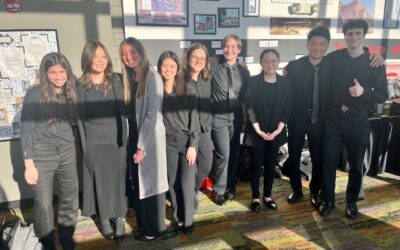Federal infectious disease expert Anthony Fauci, M.D., spoke with Gov. Gina Raimondo Thursday on a call that was streamed on the governor’s Facebook page. Below, we offer a lightly edited transcript. You can also watch the call HERE.
 Gov. Raimondo: In Rhode Island, we have had a motto of “facts not frenzy.” And, frankly, that’s what I love about you – just the facts, let me tell you the data, the science, and the facts. I find every time that you speak, I breath a sigh of relief. Don’t give me the politics, just give me the facts – everyone here is anxious to hear that from you today. I have about 500 questions from Rhode Islanders. I don’t think we’ll get answers to all 500 in the next half hour. I’m going to do my best to get through a few but I wanted to give you a chance to say a few words.
Gov. Raimondo: In Rhode Island, we have had a motto of “facts not frenzy.” And, frankly, that’s what I love about you – just the facts, let me tell you the data, the science, and the facts. I find every time that you speak, I breath a sigh of relief. Don’t give me the politics, just give me the facts – everyone here is anxious to hear that from you today. I have about 500 questions from Rhode Islanders. I don’t think we’ll get answers to all 500 in the next half hour. I’m going to do my best to get through a few but I wanted to give you a chance to say a few words.
Dr. Fauci: I’ll just say a few words but maybe my few words will answer a few of those questions. So, the topic de jour, understandably, is the issue of getting children back to school. Our default position … we try to the best of our ability to get children back to school … mainly because of the deleterious effects on children when they are kept out of school.
In some counties … children rely on school to get a good health breakfast and sometimes lunch. Also downstream ripple effects on families if parents have to disrupt their work schedules if children are kept out of school.
There’s a big “however” there. And I think the “however” is the thing that confuses people. The “however” is that the primary consideration should always be the safety, health and the welfare of the children, and of the teachers and of the families of both of those groups.
The reason there is confusion is that there’s a large degree of heterogeneity in our country. We have a beautiful country but it’s big. It’s very diverse both demographically and geographically and, importantly, in the level of infection. For that reason, we’ve designated red states, yellow states, and green states, depending on the level of infection in your state. If you’re a green state, you have less than 5 percent positivity, which is less than 10 cases per 100,000 [people]. If you’re yellow, you have between 5 and 10 percent positivity, with 10 to 100 cases per 100,000. And in a red state, you have more than 100 cases per 100,000.
Rhode Island happens to be, fortunately, because of a lot of the things you’ve done correctly, to be well into the green state, I think it’s something like 3 percent or 2 percent positive. Which means, if you have in place, the ability to identify, isolate and contact trace … then you should be able to open up safely and clearly.
There will always be cases. The question is, how do you prevent those blips of cases from becoming something that obviate the whole program. And that’s what you’re preparing for. … And you’re starting from a very good place.
If I were talking to you and you were a red state, I’d say well wait a minute. You’ve got to tell me a lot more about what you’re trying to do and what you have in place.
GR: In a school, what does safe look like? What does that mean to be able to get kids back to school safely and the teachers safely? You’ve seen our plans. … We’re focused on PPE, cleaning, testing, mask wearing for the children. Are we focused on the right things? Are we doing enough … for this to be safe?
AF: In my impression, you are. What we have said in general … is that they are about five [things to do]. One is wearing a mask, social distancing to the extent that you can and if you can’t, then make sure you have a mask, avoided crowded congregation, outdoors is always better than indoors, good ventilation – keep the windows open when the weather permits. When you have children outside, try to make sure they don’t congregate very closely. Make sure they’re aware of safe distances. The PPE you’re talking about. … When you look at the CDC guidelines for school opening, I think you’re right there, at least from what I’ve seen. … I know that your health officials in Rhode Island are keenly aware of that.
Nothing is 100 percent and it’s how you respond to the outlier that counts. It’s important. Are you starting from a good place? The answer is unequivocally yes. You have in place understanding … to mitigate the likelihood of spreading the infection. Third, you have the capability of responding when you do get the inevitable case of someone testing positive. And the answer is yes.yyyyyyyyyyyyyy
GR: If you were a parent in Rhode Island, or you were a teacher, having to go back to work, what questions would you ask? What does that mean, are you capable of responding?
AF: Are you capable of identifying ahead of time a child who might actually be infected …. When you do have someone who comes to school and you ask them the question you should be asking, “How do you feel today?” Those are simple things you can do very easily in a few seconds.
You decide if you might want to test them or not. And if you do, test them, keep them out of circulation for however long it takes… If they have a mask on, is a very good way to keep them froom spreading the infection to other children until you can confirm whether or not they’re feeling a little tired today means they’re infected. Particularly the other children have masks and the teachers have masks.
GR: I notice you have the window open in your office.
AF: I do!
GR: You clearly believe what you’re saying. One of the questions we’re receiving a lot of is what are your recommendations for outdoor eating or learning … ?
AF: To the extent that you possibly could do that, I would get outdoors as much as you possibly can. If you look at the super-spreader events that have occurred – I think it’s incorrect to call people “super spreaders”; the event’s a super spreader – they’re almost always inside … in nursing homes, meat packing [plants], prisons, choirs in churches, congregations … It’s almost invariable that it’s indoors. Not 100 percent. So, when you are indoors, make sure you have a mask. When you’re outdoors, keep the mask on but if you could have recreation periods where children are separated 6 feet or more and keep them outside as much as possible, that would really be preferable. It depends on the school. You could have some classes, if you have the ability, you could have children sitting on the side of a hill and have the teacher give a lecture. That would be great. If you don’t, that would be ok too.
GR: What about on buses?
AF: I definitely, keep a mask on and keep the windows open.
GR: Ripple effects … It’s not so good for kids to at home. There are ripple effects, there are downsides. Could you talk a little bit about that please?
AF: Psychologically, separating children from the normal interaction in school with their peers, that’s number one. Number two, the ripple effect on the parents, who may have to interrupt work. Which may cause the next ripple effect, by having a negative effect on the economy. So what we’re trying to do is safely, prudently, open up the country, get the economy back to a healthy level and get rid of a lot of the unemployment …
When children are at home, there is an increase in child abuse because of the frayed tempers of people feeling claustrophic together…. The teachers, who are often monitors of unfortunate things that happen at home, you don’t have that check from the teacher who’s only looking objectively at the welfare of the child. They say reporting of abuses is way, way down because teachers are an important safety valve against that. And then ideas about healthy lunches, healthy breakfasts, exercising….
GR: We’re seeing all of that in Rhode Island. Immunizations are way down. Kids are gaining weight. Depression and suicide attempts are way up. Domestic violence calls are through the roof. … and we’ve already been doing this for six months. The strain is real.
This is one of my favorite questions, from a woman named Andrea. She asks, “Putting politics aside, if reopening schools were up to you, Dr. Fauci, what would your recommendation be?
AF: It would be depending on where you were. I think to say, all schools must close; all schools must open is not the adequate or correct approach. You’ve got to be flexible because I know I get asked this a lot. … If you’re in a green zone, it’s likely with a couple of simple things in place, you can do what Rhode Island is trying to do. If you’re in a yellow, you need to be a little bit more careful … and if you’re in a red zone, you’re really better be very careful.
The best way for a state, a city or a county that’s red to get their children back to school, is to do what’s needed to become yellow and to do what’s needed to become green. It’s in your purview, you can do it. … I say, you want to open your schools? Get out of the red. Do you what you need to do. Close the bars, forget congregations with a lot of people, wear your mask, because we know when you do that, you will bring the infection down. And when you bring the infection down, then you go to the yellow … and then the green.
If you’re in a red state, you have a choice: either close the bars or close the schools. If you have people congregating in bars, it’s likely you’re going to stay red.
GR: Last week I decided to say that all bar areas of restaurants had to close at 11 o’clock. … But you know, it’s summer, people want to have parties. People want to have pool parties, people want to go to the beach. If you have any magic ways to get people to follow the rules, I’d love to hear it because it is a challenge.
AF: I would encourage people, because sometimes when people say, “Be careful” … when I see people out on a beach running with nobody around them, I say, good for you! Do it. You don’t need to be locked down outside. If you think you’re going to get close to people, flip a mask on.… I think people go from one extreme to another. You’re either going to lock yourself in a closet or you’re going to be out partying with no mask. You can see your friends.
GR: We have a lot of teachers who are anxious …. They’re afraid. It’s emotional, obviously. What do you say to give those teachers some comfort that it’s going to be safe to go back to teaching.
AF: It’s going to be safe … because you happen to be in a state … in which the infection rate is so low that the chances of getting infected are so low. Add to that, wearing a mask and doing the things we’ve been talking about. … It’s never going to be risk-free. But for goodness sake we are living, all of us, in an historic pandemic…. It really is a challenge. You can’t interrupt your life totally indefinitely. You’ve got to try to safely get back to normal. And the way to safely get back to normal is make sure your state, your city, your county, is green – which it is – and make sure it stays green. You may have heard me say, we help each other. So all of us can help alleviate the anxiety of the teachers and the parents by, apart from school, doing everything we can to keep the community green…. Your responsibility doesn’t end at the school room door. It’s throughout your entire existence…. If you want to keep the state green, do the five things I talk about: masks, social distancing, no crowds, outdoor better than indoor, wash your hands frequently. You do that, you’ll stay green and you’ll be safe.
GR: For the towns that aren’t green, we’re recommending that they start on a virtual path, in person for the younger kids, but virtual for the older kids. We’ve been very serious about it. … We’ve learned the high school students did better with distance learning. The younger kids really struggled…. We’re hoping to go back Sept. 14 and we’re hoping to use the next month to shore up our testing. I told everybody I won’t open schools until I know test turnarounds are 48 hours, maybe 72 hours. Make sure contact tracing is where it is. Make sure there’s ample masks for all the students and all the teachers. This is what we’re doing…. Our goal is what you said: get as many students in school as possible.
AF: You’ve done a really good job. Keep it up. This will end. And it will end with a combination of maintaining the public health principles that the governor and I have been speaking about, together with my cautious optimism about a vaccine by the end of the year, the beginning of next year. … the more effort you put into keeping yourselves as green as possible, the better. … We’re going to be, a year from now probably, celebrating how we got through this together.
If you value what you find on East Greenwich News, please consider making a donation. We are a 501(c)(3). Here’s a list of some of our donors – we’d love to add your name! Use the button below or, if you’d rather mail something, send it to EG News, 18 Prospect St., E.G., RI 02818. Thanks – every contribution helps.






 Subscribe
Subscribe